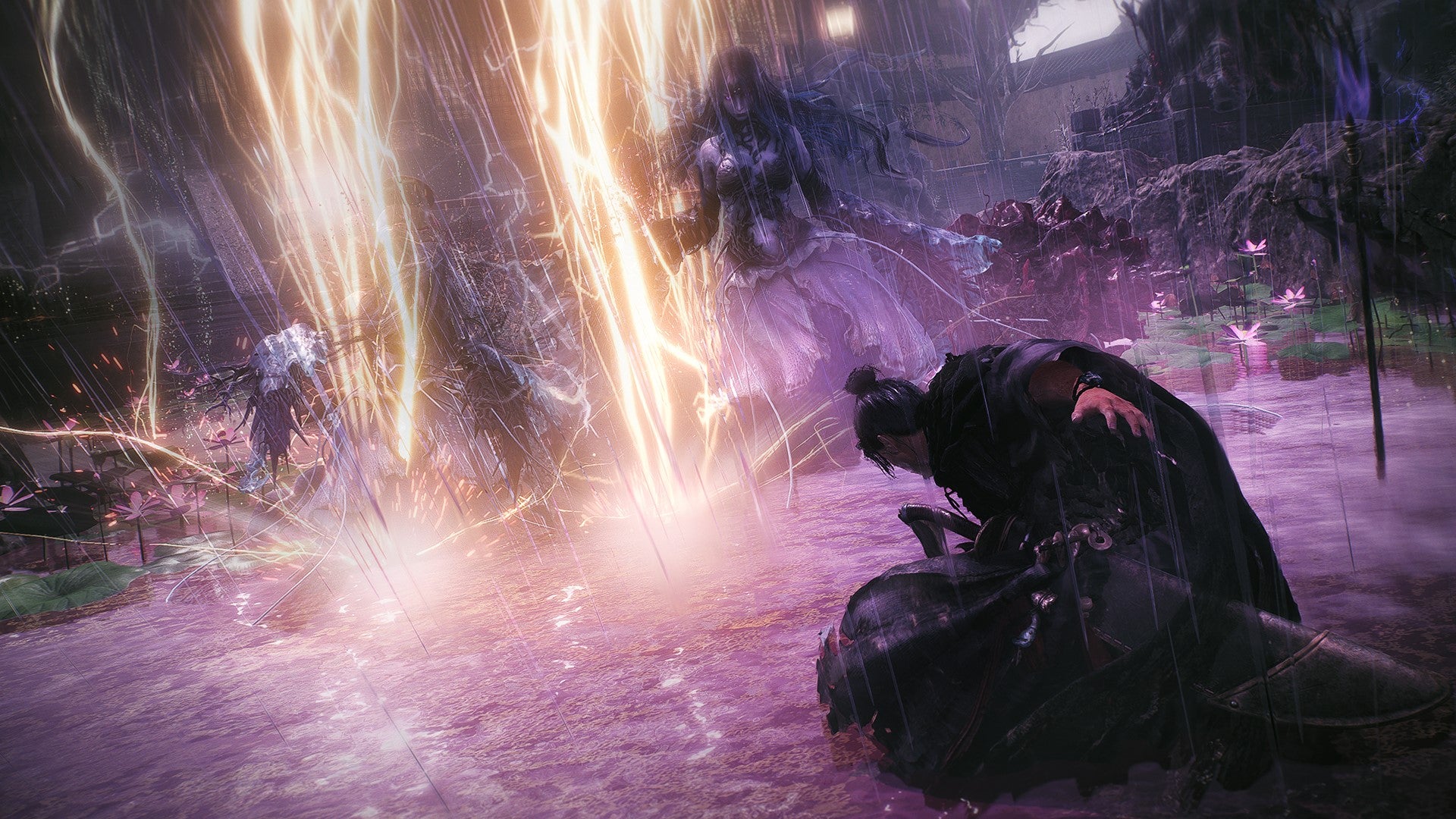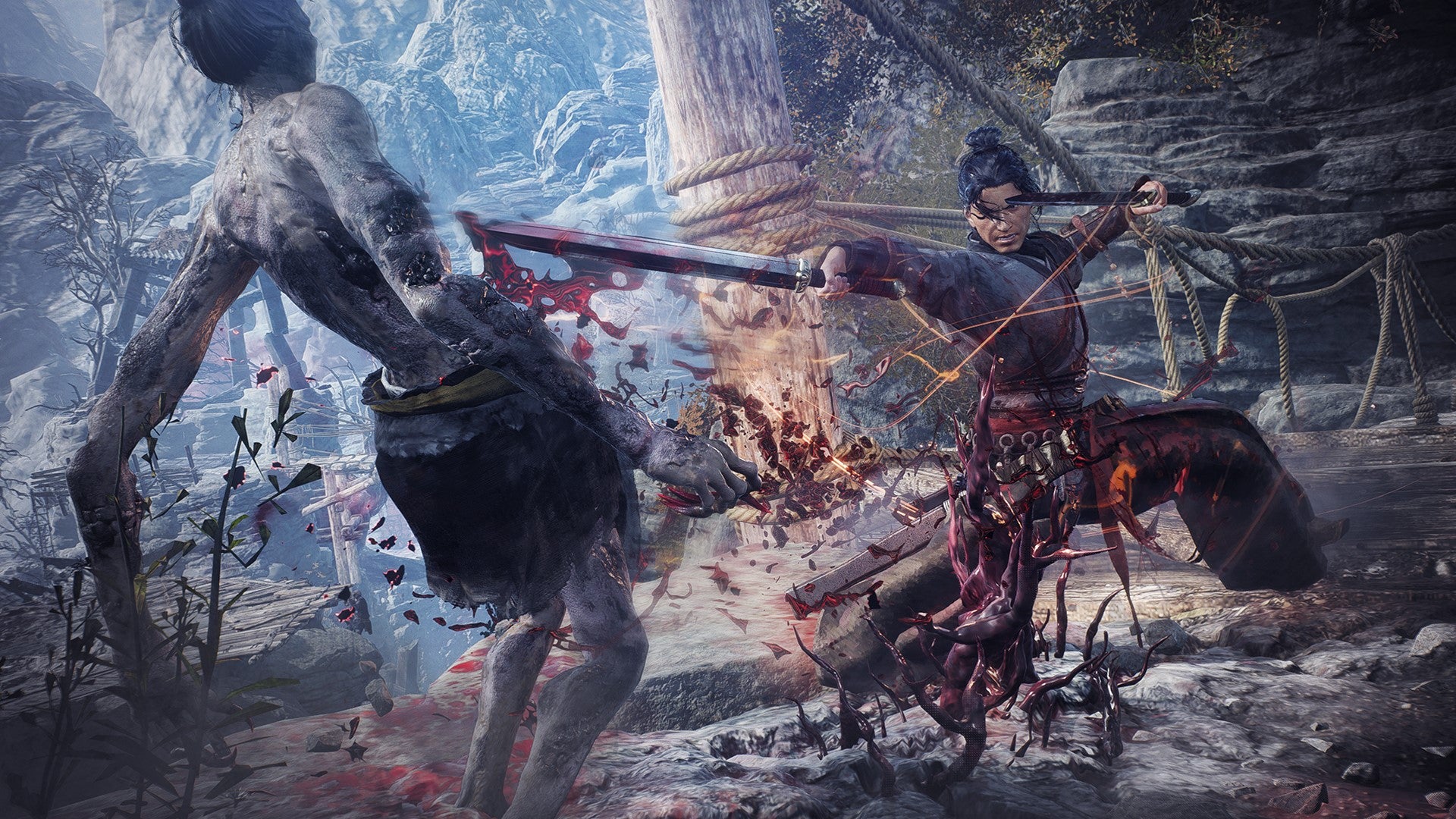The first demo dropped me into an arid encampment set into the mountainside, the sort of place I’d imagine most soldiers would get dust in their eyes if the wind blew. I’d already selected my character, having been given several templates to choose from that corresponded to different elements and such: fire, water, wood, metal – you get the idea. These determined what points would be allocated in my build, my Divine Beast special moves, martial arts (weapon-specific special moves), and the “Wizardry” spells I’d be assigned. Fire meant a focus on dealing damage with – who could’ve guessed – fireballs and the aid of a fiery phoenix that spat burning feathers, while Water, a personal fave, was a stealthy spellcaster whose stats maximised ice build-up and could summon Blastoise’s granddad into battle to mini-gun a demon to death with water pellets. There was great versatility to the builds available, as I could mix and match my abilities easily as I progressed through the encampment. I may have started with fiery spells, but soon enough I’d visited a Battle Stand (a.k.a. a bonfire) and transformed my character into more of a poison-slinging menace. While it was hard to get a sense of whether this would be as easy or effective in the final game, I loved being able to alter my spells and strengths with zero penalty, especially as Soulslikes often make you pay for the privilege. Wo Long won’t let you use these abilities unless you’re aggressive, though. It yawns at those who sit back and absorb blows, waving them off for a quick execution. This is to do with the game’s spirit meter, which is one of two systems that add a layer to combat that’s very typically Team Ninja. The spirit meter is a bar with a positive and negative side, acting quite similarly to a poise meter found in other games. Take damage, dodge, block, or use your martial arts abilities and you’ll enter the negative. If you’re maxed out on the negative side, taking a hit will stagger you, leaving you wheezing and rooted in place until you recover. It’s Wo Long’s way of egging you on in fights, whether you like it or not. To counterbalance the negative, you must take risks for rewards, lest you sit back and wheeze to death. Successfully striking enemies puts the spirit meter into the positive, which lets you block and dodge and use your spells more frequently, sometimes with zero penalty. Enemies have a spirit bar too, so it’s important to apply pressure so their meter isn’t swelling with positivity. And after coming up against enormous, demonic porcupines that lashed out with their claws and curled into a spiny ball of rolling death, I’d say the spirit meter is a neat twist on the traditional poise or stagger meter we’ve seen in other Soulslikes. Where often they’re just bars you try to fill quickly, with one reward and little downside to being defensive, Wo Long forces aggression and rewards you handsomely for it. Of course, you can play defensively, but because activity is key you’ll find that combat transforms from patterns of dodging and striking to exchanges of momentum. Case in point: I’d wait for the devil porcupine to curl up into a ball and then smash dodge to spin out of its way to build some spirit. In another game I might have waited to counterattack another roly-poly, but here I found myself lunging forwards to secure a hit before the porcupine had a chance to gather itself. I’d become a glutton for spirit! Morale Rank is the other Team Ninja combat layer, about which I was less of a glutton and more overly protective. Essentially, both you and your enemies have morale ranks, and if you defeat an enemy with a higher morale rank than you, then your own rank will increase and you’ll find more valuable items. Not only will it be a more challenging battle, but losing will result in a loss of morale. I suffered this against the porcupine, until I came back to life, locked eyes with it, swore revenge, and reclaimed my honor. Aside from porcupines, much of my time with the first demo was spent fighting a BIG PIG, who was incredibly angry about something. It would leap and stomp, wind up for a BIG charge, and occasionally stamp the earth and send waves of BIG rocks that surged towards me. I can see why the devs planted Big Pig in the way, as ingrained all of Wo Long’s combat systems into my muscle memory. And once it clicked, I’d say it felt on par with Nioh’s wonderful rhythm - even surpassing it in terms of approachability. But it was impossible to tell how many fathoms deep the loot, gear, and combat could go in such a carefully curated demo. Will it be a Diablo-esque grind? Is there an overworld or a blacksmith to upgrade gear? Does it par all of these things off for a more streamlined experience? We’ll have to wait and see on this front. Still, the spirit exchanges really help to establish more of a back and forth between you and the enemy, and the weapons were a joy to use too. I settled on a dual-swords for flowy, slashy combos at short range, backed by a glaive that delivered hefty hits from afar. In the second demo (which was a slight variant on the PS5 demo), I fought a snarling tiger and a demonic dude with a spiky, tumorous lump for a fist, both tricky encounters that forced me to tinker with my wizard spells until I settled on an earthy sludge that ticked an enemy’s health down whenever they stood in it, alongside some poison coatings for my blades. The best form of scumbag build. As for my journeys to these horrid bosses? Exploration in both demos was akin to Nioh, with corridors leading to larger zones. There’s a greater degree of verticality, though, as there’s a dedicated jump button that lets you hop up to rooftops and scale ramparts. I’m pretty sure there were a few pathways blocked off in each of the demos, so – surprise surprise – it was hard to get a sense of just how sprawling they could’ve been. And pathways being blocked off largely sums up the demo experience: a very small, carefully selected taster of what to expect from Wo Long: Fallen Dynasty. Despite this, I had a fantastic time, and developed a real sense of mastery by the time I’d finished up. I wouldn’t say it was a major elevation of the Soulslike genre, or a monumental switch-up from Nioh, but I hope it will be a welcome addition to the space that’ll delight fans who just want tricky fights against BIG PIGS.





